Are You A Vanguard? Applications Now Open
Photo by Andy Heatwole
This is your first of three free stories this month. Become a free or sustaining member to read unlimited articles, webinars and ebooks.
Become A MemberStand in the front yard of Jennifer Roberts’ house in San Marcos, Texas, and it’s hard not to notice the giant wall across the two-lane street. More than 40 feet high and stretching about a half-mile down River Road, 20 apartment buildings form an imposing physical barrier — and represent a true change in her city. Residents of the roughly 300 units and 1,000 bedrooms are mostly Texas State University students.
The complex, called Woods of San Marcos, now blocks the view that those in Roberts’ longtime family home have enjoyed of trees along the San Marcos River. Fed by springs that have attracted settlements to the area for more than 13,000 years, the river and its pretty banks have been used by generations of San Marcos residents as a place to cool off during the long hot summers. It’s also been a spot where, for many years, college students and “townies” mixed together. But the City Council’s development decisions and the boom in private student housing have made that typically tricky relationship tenser in recent years.
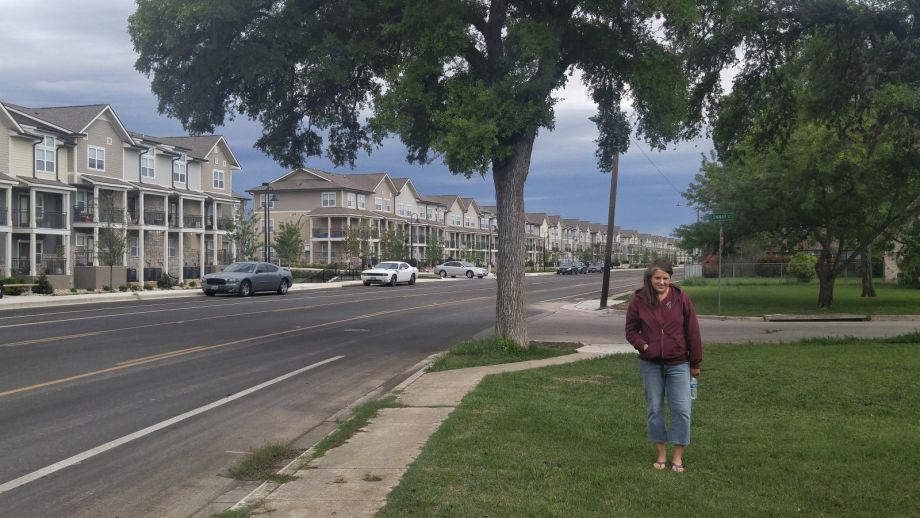
Jennifer Roberts stands in the front yard of her home across the street from the Woods apartment complex. (Photo by Meredith McGraw)
San Marcos, population 58,000, was listed as the fastest-growing city in America according to 2014 census data. The growth is mostly thanks to an expanding Texas State University — the largest employer and largest property owner in the city. With the anchor institution showing no signs of slowing down and the invasion of national developers that have seized on a growing real estate opportunity to provide housing for an increasing number of college students, city residents find themselves much more concerned about the consequences of that growth — including rising rents and flood waters — than noisy parties.
“It’s not that I’m against growth, it’s just that this area has been consumed by Texas State, and everything we have now is for the students, and no one thinks much about the people that have lived here for a while,” says Roberts, who owns a sales and marketing business. “I know many people who have lived in San Marcos for years who have moved out, because almost every neighborhood in town now has one of these huge apartment complexes right next door to them.”
Kevin Romig says that’s exactly what drove him to leave Texas State in 2013 — after he was granted tenure — for Northwest Missouri State. “I used to tell my students that [San Marcos] should be used as an example of what not to do when planning a city,” says Romig, who specializes in urban planning and water resources.
Tensions have been simmering in the San Marcos community for many years, as Texas State has grown from about 22,000 students in 2000 to its current student body (undergrad and grad) of 38,000. The school has long been the big player in town, but while it has set a new enrollment record for 18 straight years, it hasn’t increased the number of on-campus dorm units.
“In big cities, absorbing big housing needs like this might not be noticed,” says Jared Miller, San Marcos city manager. “But we are in many ways the canary in the coal mine on all this, given the size of the city and the growth of the school. We are feeling the pinch now that other cities are going to be feeling very soon with the way the student housing market is going.”
For Texas State’s part, a larger enrollment helps it become more recognized as a top-tier research institution, which comes with a large amount of funding. So new classroom and office buildings were prioritized over dorms.
As the student body ballooned, private housing became an issue. The school seemed to not care much about what kind of housing was built — or where specifically, as long as it was within a 10- to 15-minute bus ride to campus.
“The school saw that they didn’t get a return on building dorms … so they figured let’s keep our hands off that and let the private developers do it for us,” says Jay Heibert, who was an adjunct business professor at Texas State University for six years. He also graduated from the school, in 1983.
Owners of single-family homes in older neighborhoods nearest to campus had the clout to keep the big apartment complexes out. The little downtown area was also difficult to develop because existing buildings would have to be purchased and bulldozed. Vacant properties farther out offered a cheaper alternative, and there were property owners who wanted to cash in. Enter complexes like the Woods — and approximately 12,000 other bedrooms built since 2012.
Taking San Marcos’ population into account, such growth would be like Austin adding 200,000 bedroom units in the space of four years.
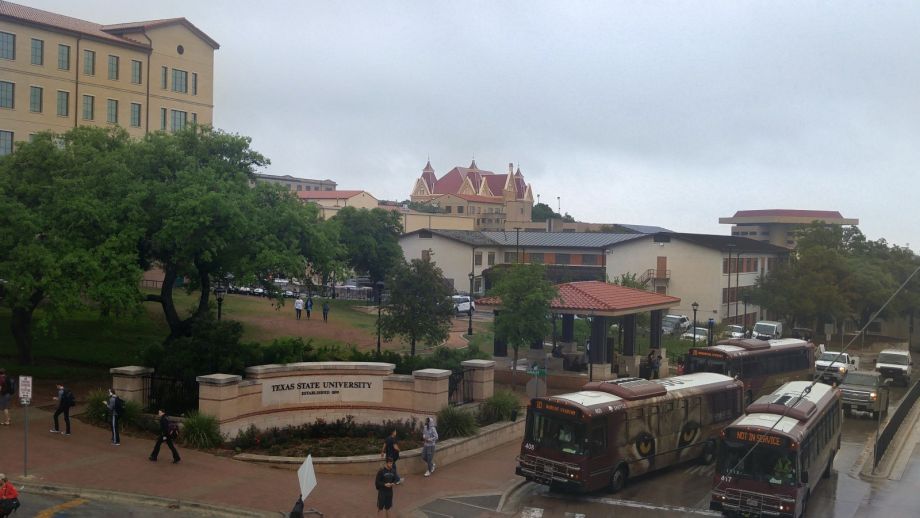
The Texas State University campus (Photo by Meredith McGraw)
“As far as we know, the school has never asked whether the environment in San Marcos could support a growth of so many people,” Heibert charges. “I would argue it cannot, given the water issues in this part of the state and having to build student housing in flood plain areas. San Marcos is the bastard child of the university, and the school really makes no effort to interact with the city.”
Indeed, the school does not see planning for housing as part of its purview. According to its master plan, the school expects to grow to 50,000 total students by 2020, which will leave San Marcos looking to accommodate 12,000 more students, likely with off-campus apartments.
“There is not a plan where we work with the city and say we have 5,000 students coming in and we need additional housing,” says Joanne Smith, vice president of student affairs for Texas State University. When asked why they don’t get more involved, Smith says, “That’s a good question.”
“We have never said to developers or the city we want housing in one place [or another],” Smith adds. She says the school’s main concern with off-campus private housing for students is the efficiency of bus lines operated by the school, which were paid for by about $6 million in student fees last year (about $200 per student). “We are most concerned that students can get to class,” she says.
As far as adding more dorm units on campus, Smith says their priority is having enough for freshmen (who are generally required to live on campus). That incoming class was about 7,500 this year. New dorms are being built as older ones are torn down, but the replacement units don’t offer any net gain. About 27,000 undergrads now live off campus in San Marcos, and longtime residents feel the dominating presence of the complexes that have been built to house them.
These private apartment buildings essentially create a separate class of living in San Marcos, advertising resort-style pools, valet trash pickup (bags of garbage picked up at your door and carried to the dumpster for you), tanning beds, 24-hour gyms, golf simulators and weekly barbecue parties. Walk through the Woods, and you’ll see a pool trimmed with palm trees, party areas with grills, beach volleyball courts and cabanas. The scene is more time-share condo development in Cancun than student housing at a state school.
“I think where students live and how they interact with the campus is a very important part of the college education experience,” Romig says. “What [the university] helped create is an environment where the campus no longer matters much. They are a bus ride away and the private developers provide what they need at the apartment.”
The student apartment boom in San Marcos is a trend happening around the country — from Tuscaloosa, Alabama, to Colorado Springs, Colorado, to Charlotte, North Carolina. But how the corporatization of college housing will play out for these communities, with big anchor institutions at their center, is not fully known yet.
One thing is certain: National developers have jumped on this market opening at many “second-tier” schools with big enrollment growth (mostly in the South, and mostly in states that have cut state education financing) — and much of the money fueling it all comes from federally backed student loans. The nearly 27,000 off-campus Texas State undergrads are paying about $200 million each year in housing expenses to private real estate interests.
About 60 percent of students at Texas State get some student loans, and some of that is used for housing and other living expenses.
Here’s how it works: Schools estimate the “cost of attendance,” which informs living expenses for loan purposes, based in part on area rental prices. Texas State puts that total cost of living off campus at about $11,000 a year.
The average rental rates per person at these new apartment developments like the Woods are about $600 a month, which works out to about $7,200 a year (the apartments require a 12-month lease). As developers raise rent incrementally, the “cost of attendance” estimates will inch up as well, all supported on the back of government-backed student loans.
By-the-bedroom renting also gives real estate management more control over revenue. Landlords place four strangers looking for an apartment in a unit with four bedrooms and four baths. Each tenant has a separate lease, and the company earns more per unit. (Most of these apartment complexes tend to be part of chains, publicly traded real estate investment trusts that might operate 40 apartment complexes of similar designs in college towns across the country.)
The median rental housing cost in the U.S. is about $1 a square foot, with big metro areas like New York getting $2 and up, and small towns like San Marcos usually in the 60-cent range. The Woods’ four-bedroom units, about 1,750 square feet total (including the shared living room and kitchen), are priced at $625 per bedroom. That total of $2,500 a month works out to be about $1.40 a square foot.
With rent-by-the-room apartment complexes now the dominant product in the market, the price of all housing in San Marcos has increased. By the city’s own estimates, 61 percent of the renters and 30 percent of the homeowners are paying more than 30 percent of their income in rental costs. According to a city report: “Many of these units are rented by young adults and college students leaving a gap of available housing for low/moderate [income] families. Although the rents for a single room may be affordable, families that need more than one bedroom often find the unit’s price prohibitive.”
Axiometrics, a Dallas-based real estate analysis firm, reports that the single-bedroom market has gotten hot in the past four or five years, and 110,000 beds have been added nationally to the student housing market in just the past two years. The average single bedroom rent is $616 nationally, according to Axiometrics, which amounts to $813 million in rent each year for units that have just come online in 2014 and 2015.
More troubling is that the popular rent-by-the-room policy dictates anyone over the age of two must lease their own bedroom. So a couple with two children would have to rent four bedrooms at these apartment complexes.
In the Fair Housing Act, HUD clearly states that apartment policies where “occupancy is limited to one person per bedroom” could be a sign of discrimination against families with children. “You can’t put in place unreasonable occupancy restrictions as it pertains to having children,” says Heather Way, a law professor at the University of Texas Law School and an expert on housing law. “You can’t prohibit children living in the same bedroom with their parents. There are exceptions — such as senior communities, but that was written into the law. In this case, with a large apartment complex that is not affiliated with the school in any way, the owners cannot institute polices that make it difficult for families with children to rent there.”
None of these large developers would comment for this story, but on a January tour for prospective tenants, complex representatives all noted that “anyone with a heartbeat needs a lease.” When asked about the presence of families with children, a guide at the Woods said not to worry, because families with children “don’t want to live here anyway.”
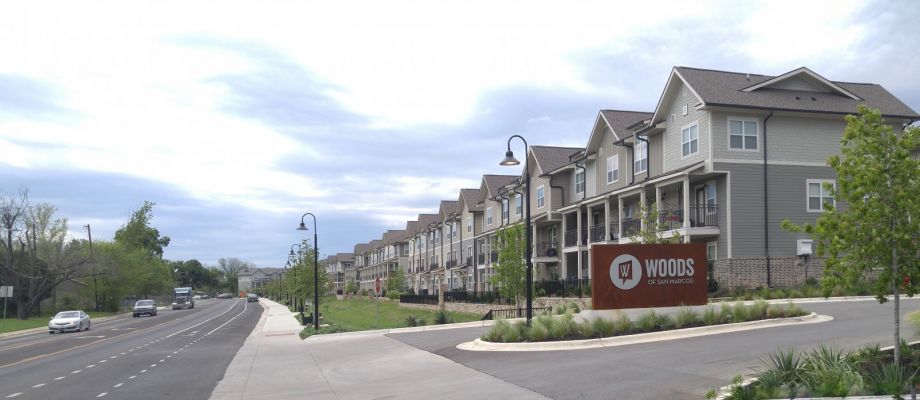
Woods of San Marcos apartment complex (Photo by Meredith McGraw)
With these rent-by-the-bedroom units becoming the norm in San Marcos (between one-third and one-half, according to census figures), families have fewer options.
San Marcos City Council Member Melissa Derrick tells the story of a woman who was transferring to Texas State University as a student — with three children under the age of 10. She was told by several apartment complexes that she would have to rent four bedrooms, pushing the monthly cost to about $2,500 a month.
The city’s data on rent increases reflects how the private student housing boom has sent average rents skyrocketing: Census records show that rents for a one-bedroom apartment in San Marcos was $548 in 2000, $695 in in 2011, and $894 in 2013. That’s a 63 percent increase between 2000 and 2013. Household income for city residents increased by just 7 percent in that same time period.
“The problem is we have let developers do what they want to in this city,” says Derrick, referring to pro-development San Marcos city councils of past.
And that build, build, build approach isn’t just pricing out renters. There are also consequences for homeowners, who are dealing with increased flooding thanks to all these new complexes.
San Macros sits in what geologists and climatologists call “flash flood alley,” the Interstate 35 corridor between San Antonio and Austin. It’s one of the most flood-prone areas in all of North America.
While rainfall can be scarce in Texas, when it hits, it hits big, especially when storms coming in off the Gulf of Mexico from the south join together with the storms from the high plains to the west. These two forces will usually meet up in the Texas Hill Country just west of Interstate 35, and as we all know, water flows downhill. A big storm can drop 10 inches of rain 35 miles west of San Marcos near Blanco, for example, and 12 hours later that water will be overflowing the banks of the San Marcos and Blanco rivers near Roberts’ house.
On Memorial Day weekend last May, 14 inches of rain fell in Central Texas. The rainfall caused flooding all over the region, and 45 people were killed in Oklahoma and Texas from the storms. Roberts’ neighborhood, Blanco Gardens, with its modest homes on concrete slabs and single-wide trailers, was inundated by water. Blanco Gardens is in a flood plain area, a V-shaped swath bounded by the convergence of the San Marcos and Blanco rivers just south, and more than 100 homes suffered flood damages that required people to move out of their homes. A public housing project in the neighborhood was damaged so severely that all 100 units were deemed unlivable and have yet to be rehabbed. Those homes represented half of the entire number of public housing units in San Marcos.
Many in the Blanco Gardens neighborhood blamed their flooding on the Woods complex, which was just finishing its construction when the May 2015 rains hit. Their instincts were confirmed by a report completed in October by a private engineering firm for the city of San Marcos: Building the Woods on 45 acres near the river added as much as 2.3 feet of water into the Blanco Gardens neighborhood for that Memorial Day rain event. As the San Marcos River overflowed its banks, the water was funneled into the neighborhood thanks to “the Woods wall” instead of being allowed to percolate into the ground and eventually move downstream.
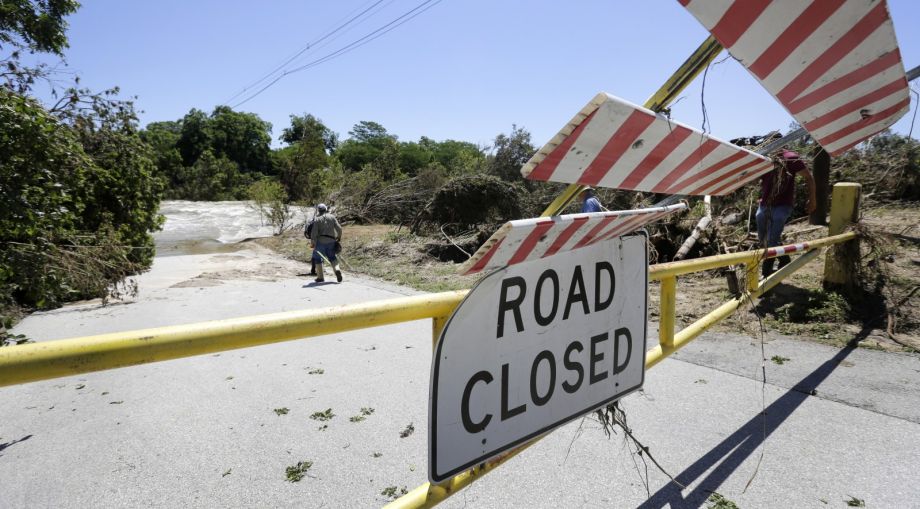
The San Marcos River flooded last May after 14 inches of rain fell on Central Texas. (AP Photo/Eric Gay)
Douglas Beckett, a retired educator and musician who lives in Blanco Gardens and has seen five floods there, says the water level measurements he took at his house in 1998 were 16 inches less than they were in last May. “Fewer inches of rain produced higher flooding,” he says. “And now there is proof that the apartment building on that property caused that increase. But we told City Council that would happen three years ago.”
Indeed, on numerous occasions, San Marcos residents told city leaders that building a big apartment complex on the San Marcos River at that spot was going to increase flooding. They had argued long before the Memorial Day flood — long before Woods welcomed its first student renter — that the city should buy the property and turn it into a park, which would link parks and open space to the north and the south. In a 2012 non-binding ballot, 75 percent of the residents said the city should buy the 45 acres and turn it into parkland, the best move for a growing city.
Instead, in January 2013, the San Marcos City Council approved the property owner’s application to rezone the land to allow multifamily apartments. More than 100 people showed up at the hearing regarding the change to speak in opposition. Few of them talked about traffic congestion or noise from 1,000 Texas State University students; the majority were concerned about future flooding that might occur with such a large riverfront property paved over and built up.
Council said the property owner wanted too much money for the property. After the vote, San Marcos Mayor Daniel Guerrero said, “There isn’t one particular reason, but when it comes to [the property] you need to consider it is private property. According to the family and attorney, the property was not and will not be for sale. They had every right to sue us if we were to pursue the property through eminent domain.” Guerrero also said he was swayed by the fact that the city would get 20 acres of park property near the river as part of the deal; the 20 acres was unusable for the housing development and was a way to reduce property taxes for the apartment developer.
In late October, with many residents still cleaning up from Memorial Day, another flood hit. Students at the Woods were trapped in their apartments. The U.S Department of Housing and Urban Development approved $25 million in relief funds to the city in February, some of which will help Blanco Gardens residents comply with FEMA flood plain rules. Many have found that to update their homeowners’ insurance, they’ll have to pay to elevate their homes several feet at a cost their current insurance doesn’t cover. Many houses are still unlivable.
The 2015 flooding in San Marcos prompted a City Council overhaul.
“Everybody got fed up with the old guard and the citizens booted them out,” says Beckett, an activist who had questioned the city’s pro-development policies and is now serving on the San Marcos Planning and Zoning Commission. “There was a movement going in that direction before, but the apartment issue and the flooding was the final straw.”
Two pro-development incumbent council members were defeated in November by two who had opposed the Woods complex from the beginning. That moved flipped the council from one that had routinely rubber-stamped any real estate development proposal, to one that has the votes to deny whenever it wants to.
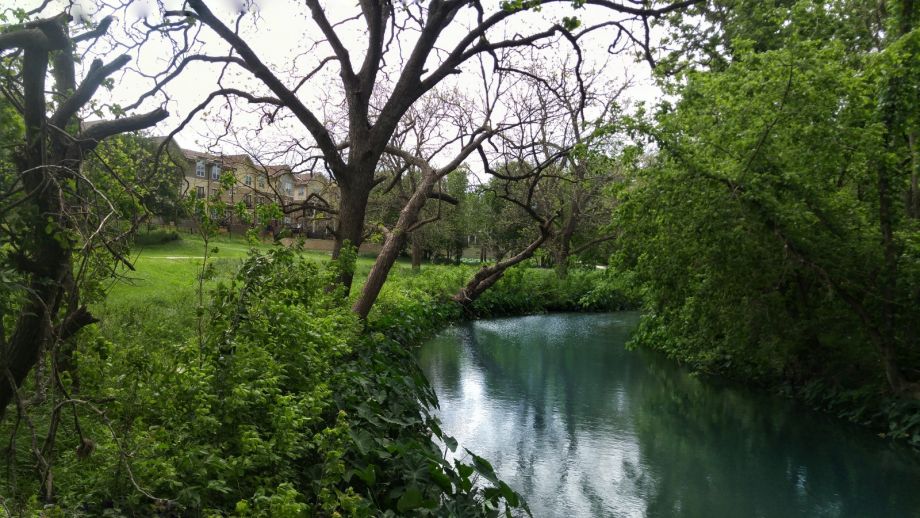
The Woods apartments line the San Marcos River. (Photo by Meredith McGraw)
“It was a tremendous lack of judgment on the city’s part to approve that apartment complex. … Most of the [former] council members were in the real estate or construction business, and the school needed to house the students that were coming there, so you can see why this project was approved,” says John Thomaides, a five-term council member who had voted against rezoning and still has his seat.
The recent backlash over the Woods has caused the city to reexamine many things. They will no longer approve multifamily housing near single-family housing. And nothing on the river. Yet Texas State is a looming presence, and many recognize that a “town-and-gown” balance must be struck.
“The school’s relationship to the city hasn’t always been perfect over the years, but we have to work with them to make sure growth happens in the best way,” says Miller, the city manager. (He started his job in 2014 after the approval of many projects.)
“The school’s growth is going to happen, whether people want it to or not,” he continues. “We had a huge rush to get apartment complexes built to satisfy that growth, and we built a lot next to single-family neighborhoods. That created a backlash. City government has heard from the citizenry on that, and we are more sensitive to it.”
San Marcos is also taking steps to address housing affordability. To respond to the fact that high rents have driven many Texas State employees to live outside the city, San Marcos offers a program that gives professors a $5,000 no-interest loan for home down payment and closing cost assistance; it’s forgivable if they live in the house for five years.
And they’re looking at the potential for a special student housing zoning that might prohibit the rent-by-the-room model, though there are many legal issues to resolve given that Texas state law regarding real estate is very much in favor of the owner and not the renter. And any zoning changes would not be retroactive.
“We are in consultation with a number of other college towns to see what can be done about this rent-by-the-room model,” says Derrick, a newly elected council member who is on the anti-development side of most issues. “There are safety issues, there are certainly financial issues. It drives up student loans over time, and it certainly drives the rental costs in the city. We are finding that we lack affordable housing for working-class people who aren’t paying their rent with student loans.”
Still, while larger anchor institutions have long played an outsize role in their surrounding communities, the growth of the private student apartment industry has added a new big player at the table. Cities like San Marcos are caught in an unreal place in terms of long-term planning. The university estimates how many students they might have by certain dates, but takes no real role in the where and when for the private housing. Cities are often forced to be reactive in the planning decisions, and must deal with pressure from the school and real estate developers and property owners to put the students in places that will not cause too many problems, but also makes sure everyone makes money in that process.
For Roberts, there is an irony in all this. Her grandparents bought a few hundred acres and farmed the Blanco Garden area in the mid-1900s (one of the streets in the neighborhood is Conway Drive, after her grandfather), and then sold plots as the city grew. But the area across the street was always open to anyone who wanted to lay around on the rocks and under the trees and go swimming in the spring-fed river. “When I was a student here in the 1990s, I hung out there too,” she says. “It was part of the community, because San Marcos is all about rivers, that’s what the city has always been.”
At that point a pickup truck with some guys who must be university students drives by, music blaring through the neighborhood. “When the last flood happened in October, some of the guys living in the apartment got wake boards and they were surfing behind their pickup trucks in front of our house,” she laughs. “That’s how students are. We don’t dislike them, but I doubt anyone wants to live next to them either.”
With reporting by Meredith McGraw
Our features are made possible with generous support from The Ford Foundation.

20th Anniversary Solutions of the Year magazine